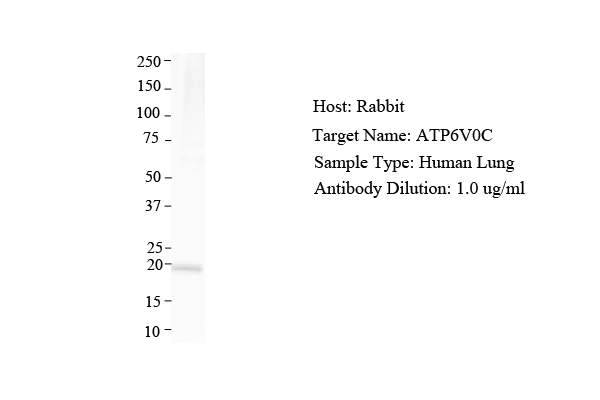ATP6V0C Rabbit Polyclonal Antibody
Other products for "ATP6V0C"
Specifications
| Product Data | |
| Applications | WB |
| Reactivities | Human |
| Host | Rabbit |
| Clonality | Polyclonal |
| Immunogen | The immunogen is a synthetic peptide directed towards the middle region of human ATP6V0C |
| Specificity | Expected reactivity: Cow, Dog, Horse, Human, Pig, Rabbit, Rat, Sheep Homology: Cow: 86%; Dog: 86%; Horse: 93%; Human: 100%; Pig: 79%; Rabbit: 86%; Rat: 90%; Sheep: 86% |
| Formulation | Liquid. Purified antibody supplied in 1x PBS buffer with 0.09% (w/v) sodium azide and 2% sucrose. |
| Concentration | lot specific |
| Purification | Affinity Purified |
| Conjugation | Unconjugated |
| Storage | For short term use, store at 2-8°C up to 1 week. For long term storage, store at -20°C in small aliquots to prevent freeze-thaw cycles. |
| Predicted Protein Size | 16kDa |
| Gene Name | ATPase H+ transporting V0 subunit c |
| Database Link | |
| Background | This gene encodes a component of vacuolar ATPase (V-ATPase), a multisubunit enzyme that mediates acidification of eukaryotic intracellular organelles. V-ATPase dependent organelle acidification is necessary for such intracellular processes as protein sorting, zymogen activation, receptor-mediated endocytosis, and synaptic vesicle proton gradient generation. V-ATPase is composed of a cytosolic V1 domain and a transmembrane V0 domain. The V1 domain consists of three A and three B subunits, two G subunits plus the C, D, E, F, and H subunits. The V1 domain contains the ATP catalytic site. The V0 domain consists of five different subunits: a, c, c', c", and d. Additional isoforms of many of the V1 and V0 subunit proteins are encoded by multiple genes or alternatively spliced transcript variants. This encoded protein is part of the V0 domain. This gene had the previous symbols of ATP6C and ATP6L. |
| Synonyms | ATP6C; ATP6L; ATPL; VATL; Vma3 |
| Reference Data | |
| Protein Families | Transmembrane |
| Protein Pathways | Epithelial cell signaling in Helicobacter pylori infection, Lysosome, Metabolic pathways, Oxidative phosphorylation, Vibrio cholerae infection |
Documents
| Product Manuals |
| FAQs |
| SDS |
{0} Product Review(s)
0 Product Review(s)
Submit review
Be the first one to submit a review
Product Citations
*Delivery time may vary from web posted schedule. Occasional delays may occur due to unforeseen
complexities in the preparation of your product. International customers may expect an additional 1-2 weeks
in shipping.






























































































































































































































































 Germany
Germany
 Japan
Japan
 United Kingdom
United Kingdom
 China
China






